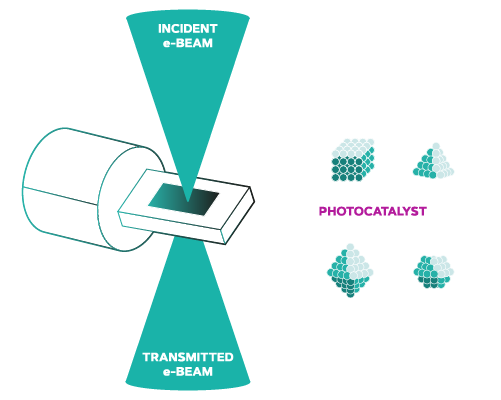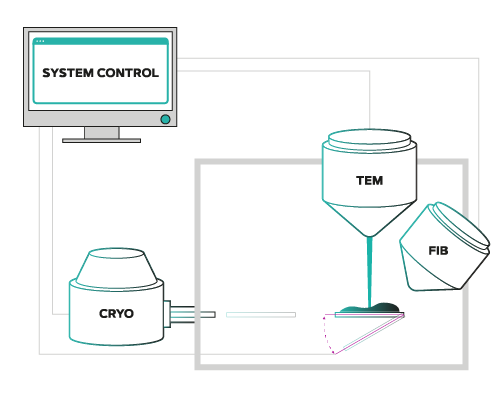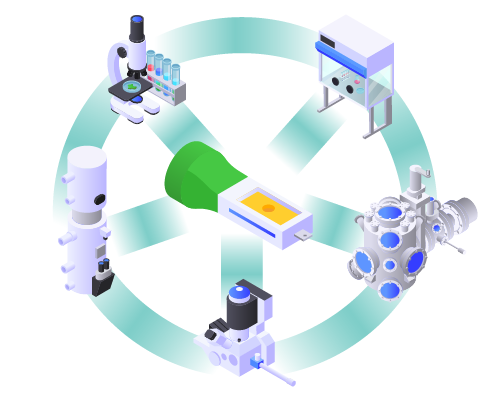WP5
- Home
- »
- WP5
In situ, Operando & Correlative
The aim of WP5 is to develop sophisticated multifunctional chips specifically designed for in situ, operando and correlative experiments.
In situ experiments involve the investigation of phenomena in their original context, while operando experiments entail real-time analysis during active processes.
Correlative workflows are proposed to integrate different modalities, to enable the exchange between different instrumentation as well as to move from model systems to real devices.
In situ, operando and correlative experiments enable researchers to understand and gain insights into sophisticated systems across scientific domains, such as working mechanisms in batteries, photocatalysis, bioimaging and ultra-fast changes in materials.
The overarching goal of WP5 is to enhance interoperability between TEM, synchrotron facilities and complementary techniques and methodologies, involving active participation from Research Infrastructures (RIs) in co-developing and applying solutions across various experimental settings.
OBJECTIVE 1
To develop workflows for the design of MEMS devices for applications in battery research
The objective is to develop multi-purpose MEMS (Micro-Electro-Mechanical Systems) devices tailored for operando battery research applications. MEMS are tiny-integrated devices that combine electrical and mechanical components on a small scale, facilitating highly compact and efficient systems.
The focus is on incorporating micro-sensors, micro-actuators and micro-batteries within MEMS devices. Microfluidic devices will be developed for liquid electrolytes in batteries and e-CAT cartridge-based electrochemical microreactors for solid-state batteries.
This activity will provide ground-breaking technological solutions for the development of novel electrochemical cells for operando experiments designed to study batteries under real conditions.


OBJECTIVE 2
To develop MEMS-based cells for photocatalysis
The objective is to design and create a MEMS-based micro-reactor for correlative photocatalytic experiments in TEM and synchrotron beamlines, explicitly focusing on CO2 reduction reactions and generation of high-value products.
The MEMS device will be designed combining vapour/gas, heating and biased operando experiments under illumination.
Precision micromachining will ensure seamless integration of the MEMS-based cell with TEM sample holders and synchrotron beamlines.
OBJECTIVE 3
To develop carriers for applications in bioimaging
The objective is to develop multi-purpose MEMS devices for biological applications. Prioritizing adaptability and transferability, the aim is to optimize the e-CAT cartridge system for cryogenic transfer of biological samples and automated sample handling.
This objective aims to establish a continuous improvement loop, incorporating user feedback and adapting to technological advancements, forming the foundation for an innovative workflow in operando bioimaging applications.


OBJECTIVE 4
To develop new instrumentation and methodological approaches for spectroscopy
The objective is to create a comprehensive platform for various spectroscopies, spanning from soft X-ray beamlines that cater to biology and chemistry to hard X-ray ones that enable structural studies of materials.
One of the two main tasks is to integrate Resonant Inelastic X-ray Scattering (RIXS) and Electron Energy Loss Spectroscopy (EELS) in a unique experimental setting. The other is to create a correlation between X-ray Excited Optical Luminescence (XEOL) and nano-CL experiments.
RIXS delves into electronic structures, EELS explores nanoscale electronic properties, XEOL studies luminescence under X-ray excitation and nano-CL observes cathodoluminescence at the nanoscale.
OBJECTIVE 5
To develop innovative workflows for investigating ultra-fast transformations in materials
This objective aims to advance the study of ultra-fast transformations in materials by crafting pioneering correlative workflows.
The task involves creating innovative specimen/aperture holders and e-CAT cartridges for specific sample environments, which will be fitted on TEMs and various spectroscopy beamlines.
The main focus is on developing and demonstrating workflows dedicated to unraveling the intricacies of ultra-fast phenomena in magnetic materials and materials that can undergo phase transformations. This multifaceted approach integrates cutting-edge technologies, including microscopy and time-resolved optical spectroscopy.

“Our innovative multifunctional chips will allow to achieve groundbreaking advancements in interoperability between TEM and other analytical instruments in a wide variety of experimental settings.”
Vittorio Morandi
WP5 Team Leader
